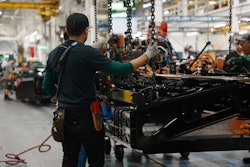I haven’t touched on it yet in this space, we at Truck Parts & Service and Successful Dealer have been doing our best to keep up with President Donald Trump’s trade war.
It’s been a bit of a whirlwind.
It started on a non-descript Friday morning in March when most in the Western hemisphere woke to see the president had been pounding away on Twitter, telling us all that “trade wars are good, and easy to win.” In the months since using social media to provide the global economy his own unique wake-up call, the president’s tweets and corresponding actions have dominated the world of commerce.
In the transportation sector, most conversations have focused on the president’s first offensive in this new battle: his 25 percent tariff on imported steel and 10 percent tariff on imported aluminum.
Automotive and commercial vehicle manufacturers were taken aback by the tariffs when they were first proposed and have relentlessly fought against them. There was a period in late March where it looked like Trump might relent a little on his opening salvo and agree to exceptions for our NAFTA neighbors and the European Union, but eventually those talks broke down. With the exception of a few solitary compromises (with South Korea on steel; Argentina, Australia and Brazil on aluminum), the 25 and 10 percent tariffs are now in effect worldwide.
Days after the tariffs hit Canada, Mexico and the EU, the Motor and Equipment Manufacturers Association (MEMA) — arguably the most vocal industry association pushing back against the tariffs — responded.
“Our members could face having to pay double tariffs on some materials necessary to manufacture parts in the U.S. Industries like ours, which require long-term investments in facilities and employees, depend on regulatory and market stability. These actions have thrown all of that up in the air,” MEMA wrote at the time. “There is little doubt that the uncertainty and added costs the administration is creating will put U.S. investments and jobs at risk.”
I absolutely understand MEMA’s concern though when it comes to our sector of the transportation world, new tariffs also could have some major unintended consequences.
Changes to U.S. trade policy have a significant impact on freight.
There are thousands of trucks operating through U.S. ports each day. Intermodal freight rates have rarely been higher. National utilization rates are surging. It takes more trucks to move freight from a port, to a railyard, to a distribution center, to a store (or your front door) than it does to go directly from a manufacturing facility to a DC and then a store.
If this trade war continues unabated and we close our doors to outsiders, there’s going to be less freight to move. And that means fewer trucks, miles driven and parts and service needs.
In its recent Truckable Economic Activity (TEA) report, MacKay & Company wrote, “In the first quarter of 2018, exports were 13.4 percent of total TEA and imports were 10.7 percent of total TEA.” That combined share of 24.1 percent is among the highest totals in U.S. history, and nearly three times higher (8.3 percent) than the same period in 1968.
As the United States has grown, our commitment to global commerce has followed. That commitment has put more trucks on the road.
I don’t have the answer to the trade problem. I realize the negative impact imports can have on U.S. manufacturing and I understand the president’s desire to fix that. But I also know that stubbornly slamming the door on an economic strategy we’ve been using for 50 years isn’t going to fix things, either.
It’s definitely not going to sell more truck parts.










